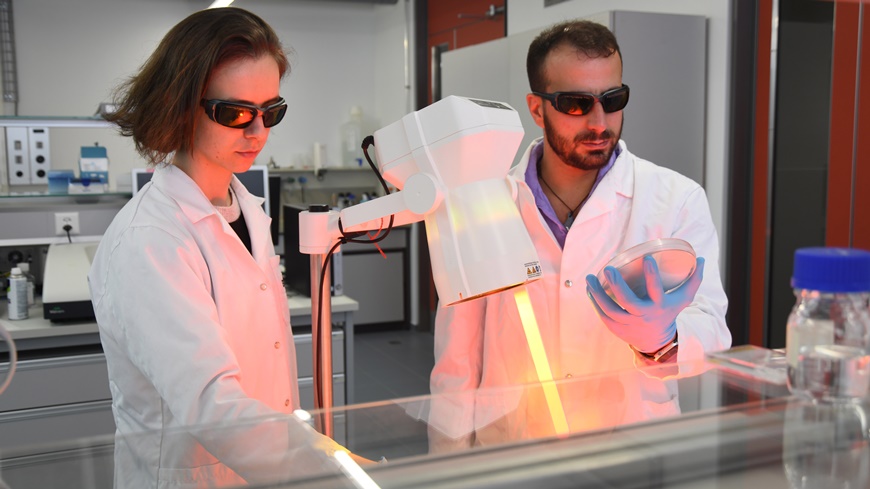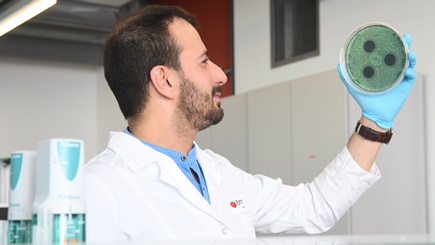Fighting antibiotic resistance
Shining a light on germs
Light on – bacteria dead. Disinfecting surfaces could be as simple as that. To turn this idea into a weapon against antibiotic-resistant germs, Empa researchers are developing a coating whose germicidal effect can be activated by infrared light. The plastic coating is also skin-friendly and environmentally friendly. A first application is currently being implemented for dentistry.


Antibiotic-resistant bacteria and emerging viruses are a rapidly increasing threat to the global healthcare system. Around 5 million deaths each year are linked to antibiotic-resistant germs, and more than 20 million people died during the COVID-19 virus pandemic. Empa researchers are therefore working on new, urgently needed strategies to combat such pathogens. One of the goals is to prevent the spread of resistant pathogens and novel viruses with smart materials and technologies.
Surfaces that come into constant contact with infectious agents, such as door handles in hospitals or equipment and infrastructure in operating theaters, are a particularly suitable area of application for such materials. An interdisciplinary team from three Empa laboratories, together with the Czech Palacký University in Olomouc, has now developed an environmentally friendly and biocompatible metal-free surface coating that reliably kills germs. The highlight: The effect can be reactivated again and again by exposing it to light.
Biocompatible and effective

“The new material is designed to kill microorganisms locally and quickly,” explains Giacomo Reina from Empa's Nanomaterials in Health Laboratory in St. Gallen. A basic matrix of polyvinyl alcohol, a biocompatible plastic that is also used in the food industry, was used for this purpose. Embedded in this matrix is specially synthesized graphenic acid, which is ideally suited as an antimicrobial coating due to its chemical properties. Its full potential can be exploited by using near-infrared light. As soon as the composite material is irradiated, it unfolds its dual strategy: Firstly, it absorbs the energy of the infrared light and converts it into germicidal heat. It also stimulates the formation of oxygen radicals, which cause additional damage to the pathogens.
Another advantage here is that this strategy is completely different from the mode of action of conventional antibiotics. The material thus offers continuous protection against a broad spectrum of microorganisms without contributing to the development of resistance. “Our laboratory experiments have clearly confirmed the effectiveness of the antimicrobial material against various bacteria and viruses,” says the Empa researcher.
Application for dentistry

An initial application for the antimicrobial coating is currently being developed for dentistry. To this end, Empa researchers are working together with the Center for Dental Medicine at the University of Zurich on a dental splint that kills microorganisms in the oral cavity.
The microbial flora in the mouth is a particularly unpleasant opponent in the fight against infectious agents: Complex communities of bacteria cavort in inaccessible niches, embedded in a self-produced mucous matrix. Antibiotics and disinfectants barely penetrate these resistant biofilms. This allows the germs to ruin teeth unhindered or even lead to extensive infections in the body. The interdisciplinary team led by Giacomo Reina is therefore working on a plastic splint into which nanomaterials such as graphenic acid can be stably integrated. As near-infrared light can penetrate the tissue several centimeters deep, the splint can be placed in the oral cavity and activated from the outside by a light source, over and over again.
The project can be started thanks to generous donations from the Eduard Aeberhardt Foundation and another foundation. Clinic Director Ronald Jung from the Center for Dental Medicine at the University of Zurich appreciates this interdisciplinary approach to materials science and clinical research. “Such new and innovative solutions will offer great added value for patients,” says Jung.
Zukunftsfonds
Empa's Zukunftsfonds is looking for private donations for outstanding research projects and talents that are not (yet) supported elsewhere. If you would also like to make a contribution to the project, you can find our donation form here.
Dr. Giacomo Reina
Nanomaterials in Health
Phone +41 58 765 7344
Loris Pandiani
Empa Zukunftsfonds
Phone +41 58 765 47 03
G Reina, D Panáček, K Rathammer, S Altenried, P Meier, P Navascués, Z Baďura, P Bürgisser, V Kissling, Q Ren, R Zbořil, P Wick; Light Irradiation of N-Doped Graphene Acid: Metal-Free Strategy Toward Antibacterial and Antiviral Coatings with Dual Modes of Action; EcoMat (2025); https://doi.org/10.1002/eom2.70009
The silent pandemic: Antiobiotic resistant
Pocket Facts 01
Dangerous increase: Antimicrobial Resistance (AMR)
Surfaces and Interfaces
Totally superficial? You bet! What might be a bit of a character flaw in a person is actually a good thing in materials science. Because, chemically speaking, it's what happens on the surface that counts. A sound understanding of surfaces and interfaces enables everything from better electronics to more robust bridges. Whether it's biological compatibility in implants, antibacterial coatings in hospitals, or catalytic processes in the production of synthetic fuels – surfaces are crucial to all of these.
Read the EmpaQuarterly online or download the PDF version.
-
Share






